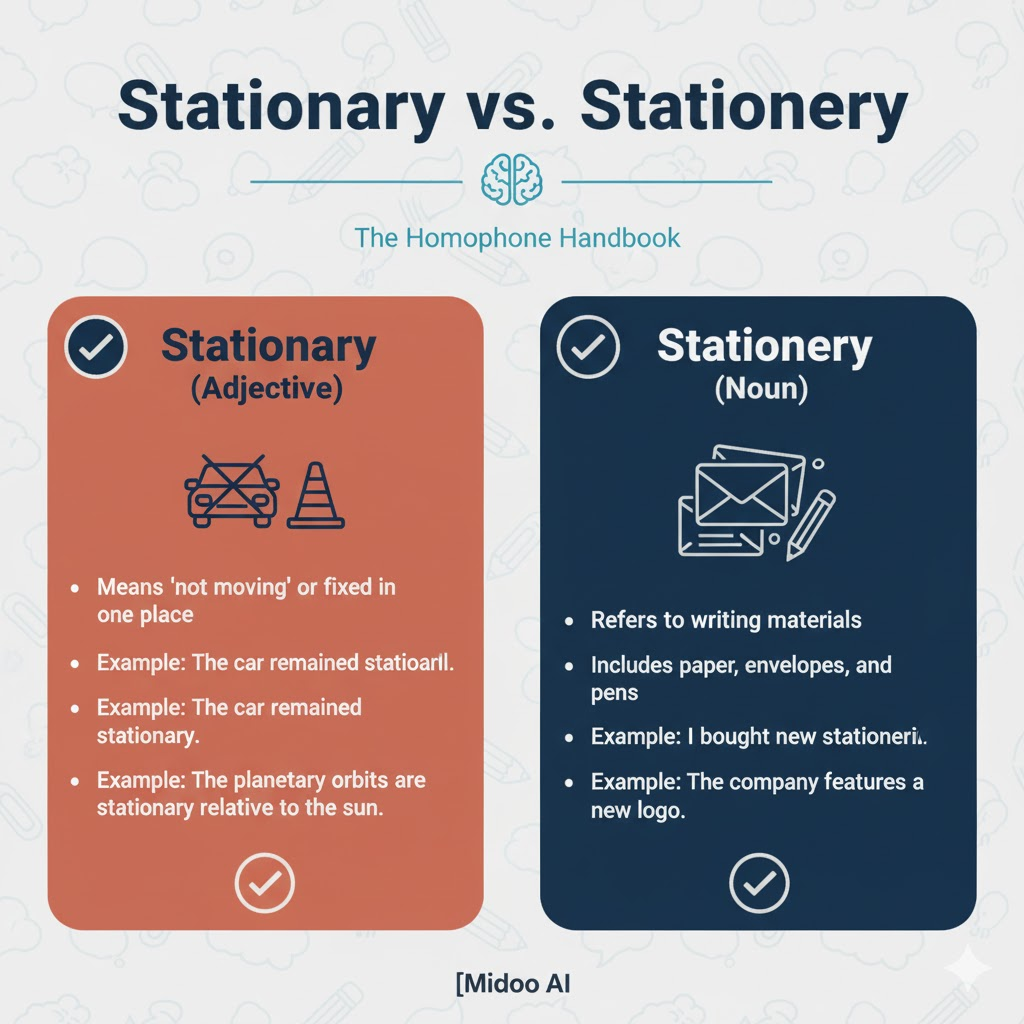Stationary vs. Stationery — How to Use Each Correctly

English learners often confuse stationary and stationery, even though these words have completely different meanings. At Midoo AI, we frequently encounter this mix-up in learners’ writing and emails. Understanding the difference is simple once you know what each word refers to, and it will make your writing much clearer.
In this article, we’ll explain the meanings, provide examples, give handy tips, and answer frequently asked questions so you never make this common mistake again.
1. Stationary — Not Moving
Stationary (with an “a”) is an adjective that means not moving or fixed in one place. It describes objects or people that remain still.
✅ Examples:
- The car remained stationary at the traffic light.
- She stood stationary while the photographer took the picture.
- The helicopter hovered stationary above the field.
- Prices have been stationary for the past three months.
💡 Midoo Tip:
Think of the “a” in stationary as “at rest”. If something is not moving, it’s stationary.
2. Stationery — Writing Materials
Stationery (with an “e”) is a noun that refers to writing materials, such as paper, envelopes, pens, and other office supplies.
✅ Examples:
- She bought new stationery for her home office.
- The company sent a thank-you note on personalized stationery.
- Students often need colorful stationery for school projects.
- The wedding invitations were printed on elegant stationery.
💡 Midoo Tip:
Remember: “e” in stationery = envelope. If it’s something you write with or on, it’s stationery.
3. Quick Comparison Table
| Word | Meaning | Example | Type |
|---|---|---|---|
| Stationary | Not moving | “The bus stayed stationary at the stop.” | Adjective |
| Stationery | Writing materials | “She ordered new stationery for her office.” | Noun |
4. Common Mistakes
❌ I bought new stationary for school. (wrong, should be stationery)
✅ I bought new stationery for school.
❌ The bike was stationery at the park. (wrong, should be stationary)
✅ The bike was stationary at the park.
Tip: Ask yourself: “Am I talking about movement or office/school supplies?” That will help you choose the right word.
5. Easy Memory Hacks
- Stationary → stays still → “a” = at rest
- Stationery → writing supplies → “e” = envelope
A simple way to remember: stationary is about staying still; stationery is about writing.
6. Real-Life Usage
- The train remained stationary for several minutes due to signal problems.
- She designed custom stationery for her wedding invitations.
- The traffic cone was stationary in the middle of the road.
- The office provides free stationery to employees.
- Photographers ask models to stay stationary during shoots.
FAQ
Q1: Can I use “stationary” to refer to paper or envelopes?
No. Use stationery when referring to paper, pens, or office supplies.
Q2: Can “stationery” ever mean not moving?
No. That meaning is strictly for stationary with an “a.”
Q3: How can I remember the difference?
- “a” in stationary = at rest → not moving
- “e” in stationery = envelope → writing materials
Q4: Are both words commonly used in everyday English?
Yes. Stationary is common in everyday conversation about movement, traffic, or objects. Stationery is used frequently in schools, offices, and businesses.
Q5: Is it okay to mix them up in informal writing?
It’s understandable in casual contexts, but in professional writing or emails, always use the correct word to avoid confusion.